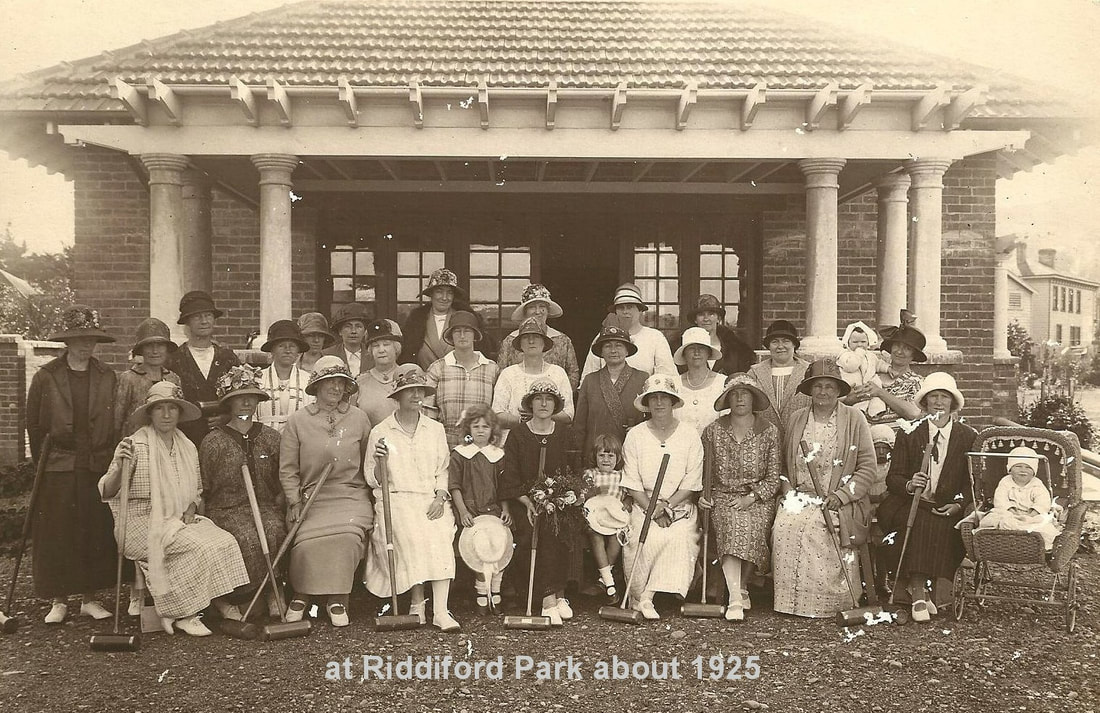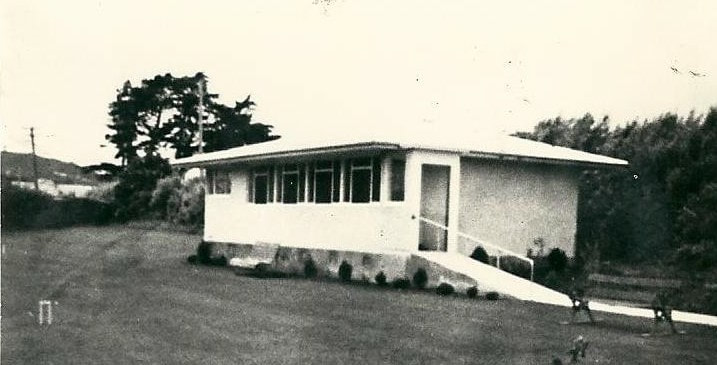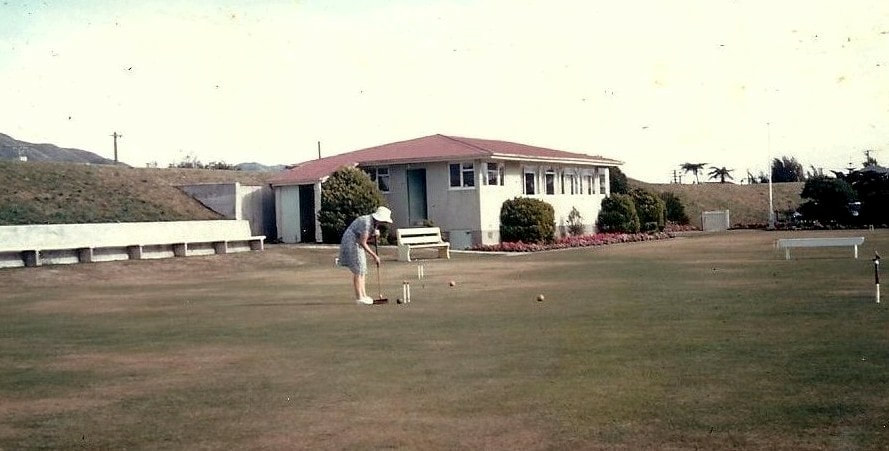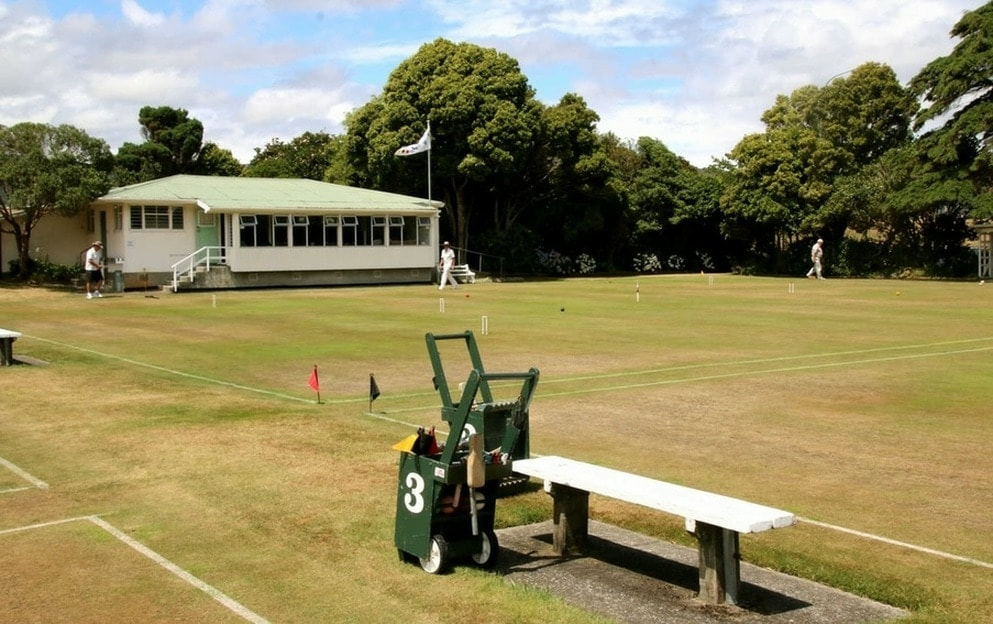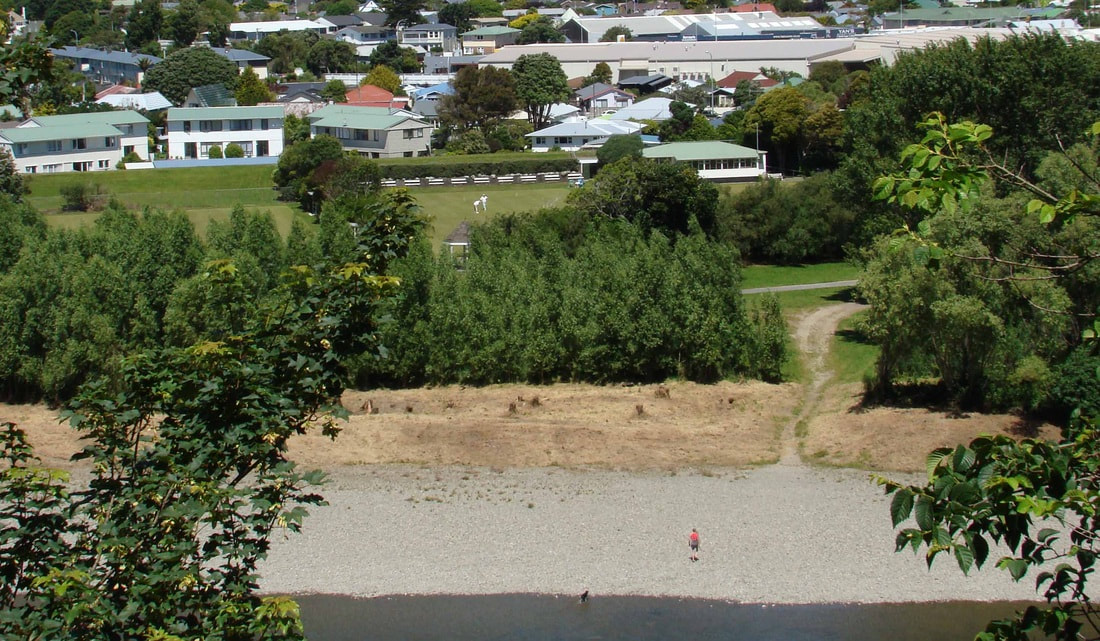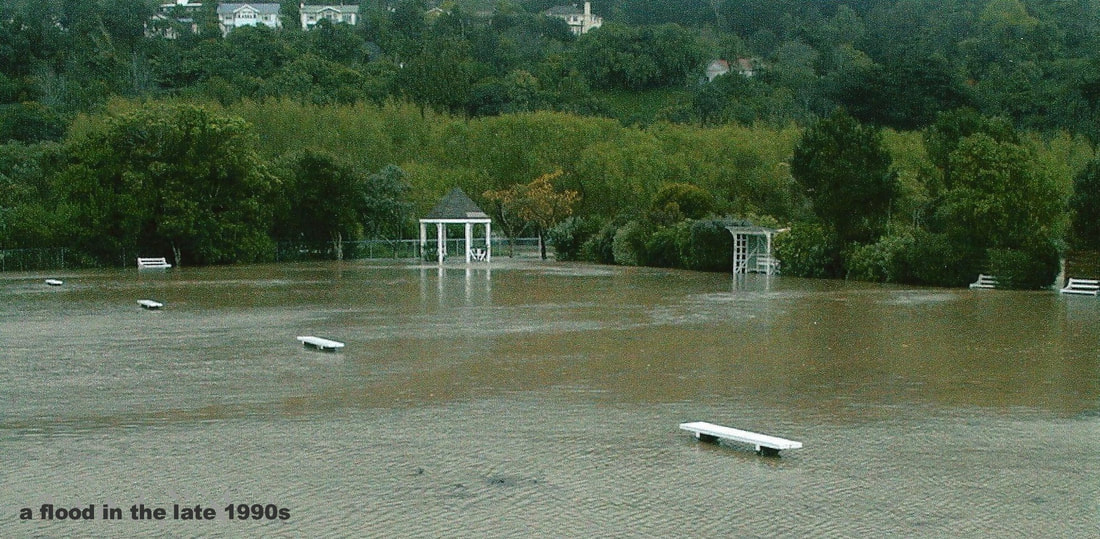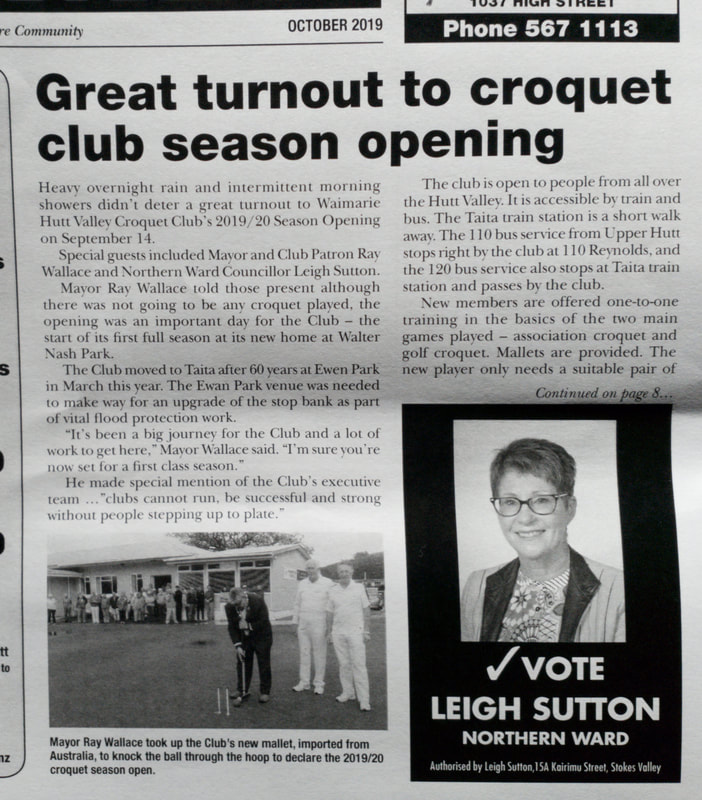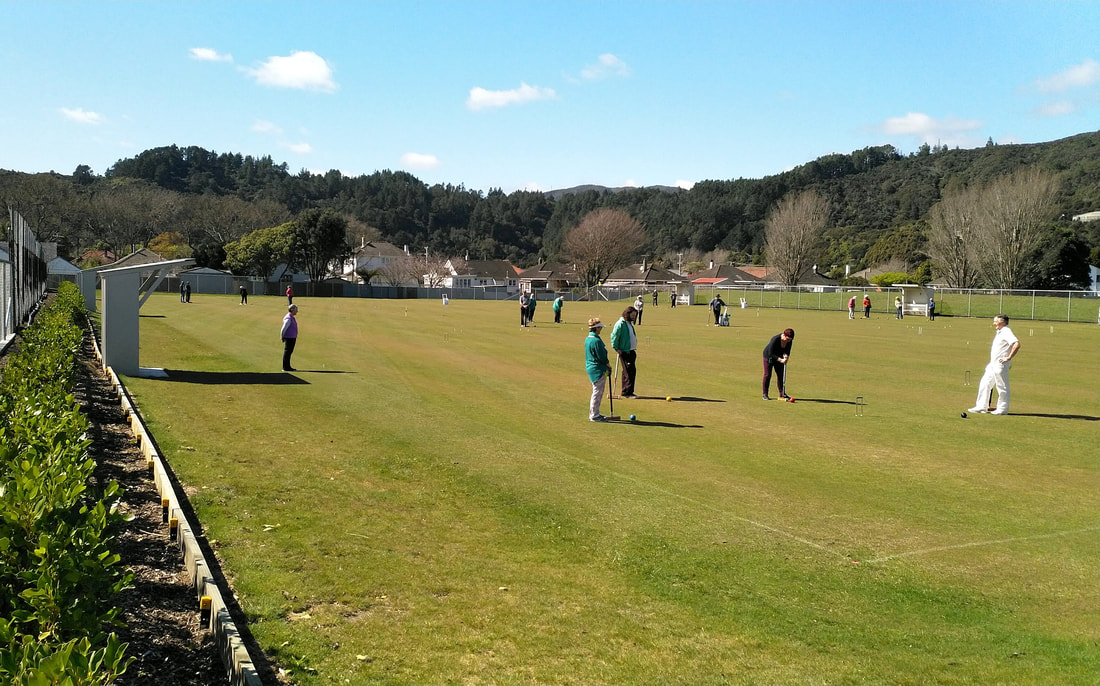CLUB HISTORY
Out of a cup of tea
One afternoon in 1922, a few friends were having a cup of tea together, when Mrs W. Strand, the Mayoress of Lower Hutt, suggested forming a croquet club.
On the advice of her husband, the Mayor, Mr W. Strand, a public meeting was called. This was held 5 November 1922 in the Council Chambers of the old Town Hall. According to the minute book very few were present because of bad weather but nonetheless three officers were elected: President, Mrs W. Strand; Secretary, Mrs J. Kelly; Treasurer, Mrs J. McDougal.
The Lower Hutt Council offered the use of two lawns in the Recreation Grounds, one just inside the Myrtle Street entrance and the other at the southern end of the grounds. The cricket club offered their club room and facilities to the new croquet club, which at this stage was without a name. A subscription of £1.5s reduced to one guinea (£1 1s) if paid within two months, was agreed.
Under way
The first committee was elected at a meeting 10 days later on 15 November 1922. The initial opening was held on 5 December 1922, with Mrs Strand declaring the lawns open and playing the first ball through a hoop.
Later the club was given two lawns together and the use of an old tin hockey shed on the present site of the grandstand in the Recreation Grounds.
In 1925 lawns were made available in Riddiford Park and a small pavilion was built on to the Riddiford Baths. Many happy years were spent there.
One afternoon in 1922, a few friends were having a cup of tea together, when Mrs W. Strand, the Mayoress of Lower Hutt, suggested forming a croquet club.
On the advice of her husband, the Mayor, Mr W. Strand, a public meeting was called. This was held 5 November 1922 in the Council Chambers of the old Town Hall. According to the minute book very few were present because of bad weather but nonetheless three officers were elected: President, Mrs W. Strand; Secretary, Mrs J. Kelly; Treasurer, Mrs J. McDougal.
The Lower Hutt Council offered the use of two lawns in the Recreation Grounds, one just inside the Myrtle Street entrance and the other at the southern end of the grounds. The cricket club offered their club room and facilities to the new croquet club, which at this stage was without a name. A subscription of £1.5s reduced to one guinea (£1 1s) if paid within two months, was agreed.
Under way
The first committee was elected at a meeting 10 days later on 15 November 1922. The initial opening was held on 5 December 1922, with Mrs Strand declaring the lawns open and playing the first ball through a hoop.
Later the club was given two lawns together and the use of an old tin hockey shed on the present site of the grandstand in the Recreation Grounds.
In 1925 lawns were made available in Riddiford Park and a small pavilion was built on to the Riddiford Baths. Many happy years were spent there.
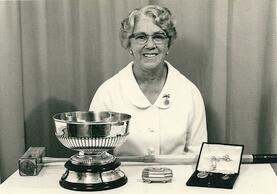 Jean Jarden with trophies won in the UK in 1970. They are:
the All England Women’s Championship; the Irish Open; the Gilbey Cup (a leading handicap event).
Jean Jarden with trophies won in the UK in 1970. They are:
the All England Women’s Championship; the Irish Open; the Gilbey Cup (a leading handicap event).
War effort – more than croquet
During World War Two, Mrs J.A. Kelly kept a “War Record Book”, in which she listed the activities of the members of the club to help the war effort. Her first entry was on Thursday, May 16 1940. She recorded the surnames of the members present and the 'articles made since beginning of the war:
4 doz. face cloths, 1 child’s nightdress, 2 child’s petticoats, 1 child’s petticoat knitted, 2 singlets sewn, 5 pairs socks, 8 pairs mittens, 5 pairs gloves, 12 balaclavas, 1 sleeveless pullover, 1 pullover with sleeves.'
On 24 May, they met again, surnames were recorded and also the “work to date”. Amongst the items such as mittens, balaclavas and hot water bottle covers were strange things such as “200 pay book covers made” and stranger still, “19 Housewifes made & filled.”
In a summary of the work made at their meetings, from 16 May 1940 to 14 September 1945, there is an item “Hussifs made filled 1020”. ('Housewifes' and 'hussifs' are little pouches of sewing gear.)
Records
Minutes have been faithfully kept, handwritten from 1922 up to 1979, and after that, typed then pasted into hard-backed exercise books.
A comprehensive list has been kept of the winners of events over the years.
The Baldwin Cup 1926 (Senior “A” Grade – Championship) was won by Mrs J. Kelly in the 1926/27 season.
Mrs Jean Jarden (one of Waimarie’s most notable players) won it a number of times between 1947 and 1978. Jean was the mother of the famous All Black Ron Jarden.
More recently Toby Garrison won it several years running as did Sue Lea, both of whom have had great success in New Zealand and overseas.
Celebrations in changing times:
quotes from the Minute Book
24 October 1947:
On the Club’s 25th Jubilee the Vice President 'decided to provide a cake and members decided to help with fruit and butter in view of the shortage of same and rationing.'
18 October 1972:
For the 50th Jubilee 'it was agreed that table wine be served with dinner.'
7 May 1981:
'the two flagons of sherry provided for Closing Day was [sic] barely enough and more sherry and fruit juice should be bought next year. The lemonade was not used.'
During World War Two, Mrs J.A. Kelly kept a “War Record Book”, in which she listed the activities of the members of the club to help the war effort. Her first entry was on Thursday, May 16 1940. She recorded the surnames of the members present and the 'articles made since beginning of the war:
4 doz. face cloths, 1 child’s nightdress, 2 child’s petticoats, 1 child’s petticoat knitted, 2 singlets sewn, 5 pairs socks, 8 pairs mittens, 5 pairs gloves, 12 balaclavas, 1 sleeveless pullover, 1 pullover with sleeves.'
On 24 May, they met again, surnames were recorded and also the “work to date”. Amongst the items such as mittens, balaclavas and hot water bottle covers were strange things such as “200 pay book covers made” and stranger still, “19 Housewifes made & filled.”
In a summary of the work made at their meetings, from 16 May 1940 to 14 September 1945, there is an item “Hussifs made filled 1020”. ('Housewifes' and 'hussifs' are little pouches of sewing gear.)
Records
Minutes have been faithfully kept, handwritten from 1922 up to 1979, and after that, typed then pasted into hard-backed exercise books.
A comprehensive list has been kept of the winners of events over the years.
The Baldwin Cup 1926 (Senior “A” Grade – Championship) was won by Mrs J. Kelly in the 1926/27 season.
Mrs Jean Jarden (one of Waimarie’s most notable players) won it a number of times between 1947 and 1978. Jean was the mother of the famous All Black Ron Jarden.
More recently Toby Garrison won it several years running as did Sue Lea, both of whom have had great success in New Zealand and overseas.
Celebrations in changing times:
quotes from the Minute Book
24 October 1947:
On the Club’s 25th Jubilee the Vice President 'decided to provide a cake and members decided to help with fruit and butter in view of the shortage of same and rationing.'
18 October 1972:
For the 50th Jubilee 'it was agreed that table wine be served with dinner.'
7 May 1981:
'the two flagons of sherry provided for Closing Day was [sic] barely enough and more sherry and fruit juice should be bought next year. The lemonade was not used.'
|
Another move
About 1951 the club was forced by Council to move again because a road and library were to be built on that area of Riddiford Park. Mr Strand mentioned to Mrs Savage, property next to the Melling Bridge that would take four full sized lawns. Mr David Ewen (later Sir David), the owner, had offered this land to the Lower Hutt City Council, as a reserve along the river, with the proviso (according to page 1 of the minutes of Monday 19 April 1951) that some of it was to be used for croquet lawns for Waimarie for all time. The club members agreed to accept Sir David’s offer and the club opened in Ewen Park in September 1952 with the first meeting in the club house on 15 November 1952 . |
Once a woman's world
For many years, like all New Zealand croquet clubs, Waimarie was a female preserve. The first male to win a club trophy was G. Mouat, who won the Routley full-bisque competition in the 1955-56 season. The first male office holder was J. Booth (treasurer) in 1976; the first male president was Alan Reynolds in 1994 and the first male captain, Eric Baxter in 1988. Today, things are a little more even. At the end of the 2013-2014 season there were 80 playing members, 22 of whom were men. |
The photo above left shows the site in 1952. The other photo pictures two of the lawns and the clubhouse in 1972, our Golden Jubilee year. Two more lawns were added at the north end in 1979, as was notable with a fence and trees separating them from the others. Together, these six lawns serves us until our move to Walter Nash Park in 2019.
Below shows a picture of our club as it looked not long before we moved from our Ewen Park site.
Below shows a picture of our club as it looked not long before we moved from our Ewen Park site.
By the river
We don’t know when (or why) the name 'Waimarie' was adopted, but subsequent events suggest it wasn’t an entirely appropriate choice. In Maori, Waimarie means “peaceful waters.” Usually the Hutt River is peaceful, as it is in the picture below looking east, showing the river, the river flats, the lawns and clubhouse, the grassy stopbank behind the lawns, and, at the back, Boulcott, a suburb of Hutt City.
We don’t know when (or why) the name 'Waimarie' was adopted, but subsequent events suggest it wasn’t an entirely appropriate choice. In Maori, Waimarie means “peaceful waters.” Usually the Hutt River is peaceful, as it is in the picture below looking east, showing the river, the river flats, the lawns and clubhouse, the grassy stopbank behind the lawns, and, at the back, Boulcott, a suburb of Hutt City.
But being on the wrong side of the stop bank, Waimarie has suffered flood damage a number of times when the Hutt River has overflowed its banks.
The flood pictured above was not the worst the club has suffered – though it may be the most picturesque! On 5 January 2005 we had two metres of water over the courts, bringing down fences and dumping a thick covering of silt all over the lawns. The flood was so severe that water went through the club rooms to a level several inches above the window sills.
The acceptance by the club of the David Ewen lawns has sometimes been a two edged sword. The site is beautiful but the floods are destructive. Why, historians may wonder, did the club ever accept a site on the wrong side of the stop bank? Did the members not think about the river or not try to pursue some stopbanking protection specifically for the lawns? Surprising if they didn't because there is a well documented history of flooding from when Hutt valley settlement first began. Was getting the site for always a strong lure? (The Hutt City Council has no record of that proviso so it has turned out to be an unbinding promise.) What's more likely is that, having explored a number of sites which were turned down by the City Council, the club was desperate to find one and this became a mana from heaven offer which was accepted quickly and uncritically.
The acceptance by the club of the David Ewen lawns has sometimes been a two edged sword. The site is beautiful but the floods are destructive. Why, historians may wonder, did the club ever accept a site on the wrong side of the stop bank? Did the members not think about the river or not try to pursue some stopbanking protection specifically for the lawns? Surprising if they didn't because there is a well documented history of flooding from when Hutt valley settlement first began. Was getting the site for always a strong lure? (The Hutt City Council has no record of that proviso so it has turned out to be an unbinding promise.) What's more likely is that, having explored a number of sites which were turned down by the City Council, the club was desperate to find one and this became a mana from heaven offer which was accepted quickly and uncritically.
A Major Change
New sites, male encroachments, and flooding have not been the only changes with which Waimarie has coped. In the 2005-2006 season, golf croquet competitons were held, prizes were given to the winners and a golf croquet honours' board was fastened to the club house wall. A game that had previously only been a fun escapade on gala days or an enjoyable relaxation at the end of new players' classes, suddenly became a serious competitive code.
Not that our club was innovative. We weren't. Indeed we were quite slow out of the blocks. We simply copied trends already showing around the country and around the world. But bringing golf croquet into club life alongside association croquet, (the established game since the club began), may well have set off a significant change in club culture. Only as the years roll by will we know. At the time this paragraph was written (the end of the 2011-12 season,) golf croquet, growing very quickly had become dominant in number of New Zealand regions, sometimes causing club splits and member migrations. Some clubs now play association croquet very little and a few don't play it at all. No such sweeping takeover has happened at Waimarie. The two codes usually play alongside each other quite happily, sharing some club day sessions and having others separately designated. Many members play both games.
Another Move
After sixty years at Ewen Park, our venue became a major issue when the club was notified by the Greater Wellington Regional Council that we will have to vacate to make way for an upgrade of the stopbank. Protecting the city from the Hutt River is high priority.
Consequently discussion has been going on for several years between the Regional Council, the City Council and our club's relocation committee to find a site. After looking at many suggestions, a site has been agreed upon at the now defunct Taita Bowling Club in Walter Nash Park, a few miles up the river. Not all members want to go there but at least it's on the right side of the stopbank!
A New Name
While preparations for the move were going on, the club recognised the need to have a clearer place in the community and in 2018 the Waimarie Croquet Club became the Waimarie Hutt Valley Croquet Club.
A New Home
After long discussions about who will pay for the conversion of that site into a croquet club, the Regional Council and the City Council between them gave technical help and a substantial sum of money, and the club put substantial effort into fundraising to help cover the costs as well. Alongside putting together the money, planning, designing and applying for consents went into developing the site alongside the Hutt Valley Darts Association who we are sharing the clubhouse with.
After over a decade of wrangling, discussing, planning and preparation, Waimarie Hutt Valley Croquet Club as it is now called opened at Taita on Saturday 2 March 2019 to begin a new era for the club.
New sites, male encroachments, and flooding have not been the only changes with which Waimarie has coped. In the 2005-2006 season, golf croquet competitons were held, prizes were given to the winners and a golf croquet honours' board was fastened to the club house wall. A game that had previously only been a fun escapade on gala days or an enjoyable relaxation at the end of new players' classes, suddenly became a serious competitive code.
Not that our club was innovative. We weren't. Indeed we were quite slow out of the blocks. We simply copied trends already showing around the country and around the world. But bringing golf croquet into club life alongside association croquet, (the established game since the club began), may well have set off a significant change in club culture. Only as the years roll by will we know. At the time this paragraph was written (the end of the 2011-12 season,) golf croquet, growing very quickly had become dominant in number of New Zealand regions, sometimes causing club splits and member migrations. Some clubs now play association croquet very little and a few don't play it at all. No such sweeping takeover has happened at Waimarie. The two codes usually play alongside each other quite happily, sharing some club day sessions and having others separately designated. Many members play both games.
Another Move
After sixty years at Ewen Park, our venue became a major issue when the club was notified by the Greater Wellington Regional Council that we will have to vacate to make way for an upgrade of the stopbank. Protecting the city from the Hutt River is high priority.
Consequently discussion has been going on for several years between the Regional Council, the City Council and our club's relocation committee to find a site. After looking at many suggestions, a site has been agreed upon at the now defunct Taita Bowling Club in Walter Nash Park, a few miles up the river. Not all members want to go there but at least it's on the right side of the stopbank!
A New Name
While preparations for the move were going on, the club recognised the need to have a clearer place in the community and in 2018 the Waimarie Croquet Club became the Waimarie Hutt Valley Croquet Club.
A New Home
After long discussions about who will pay for the conversion of that site into a croquet club, the Regional Council and the City Council between them gave technical help and a substantial sum of money, and the club put substantial effort into fundraising to help cover the costs as well. Alongside putting together the money, planning, designing and applying for consents went into developing the site alongside the Hutt Valley Darts Association who we are sharing the clubhouse with.
After over a decade of wrangling, discussing, planning and preparation, Waimarie Hutt Valley Croquet Club as it is now called opened at Taita on Saturday 2 March 2019 to begin a new era for the club.
Postscript
This club history was posted on this website in May 2012 and has been slightly altered since. It will be developed further if more useful information can be found. Here then is a request. If as you read, you notice gaps that you can fill with facts or anecdotes or photographs, or if you notice factual errors which need correcting, please get in touch with our webmaster Shaun Theobald - for his contact details please go to Contact Us
Picture Credits
Rose Jepsen took the photo of the the river with the lawns, stopbank and suburb behind. We don't know who took the other pictures.
Authors
This history was written by Dawn Dorresteijn from an earlier document which she was shown when she became secretary. Her re-write was posted on our previous website. In 2012 Mike Beardsell developed the history further. Kevin Fellows, the chairman of the club's re-location committee, wrote much of the final paragraph while the move was still in progress, John McInnes and Shaun Theobald have both made some edits and alterations in preparation for the website
